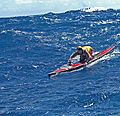Paddleboarding facts for kids
Paddleboarding is a cool water sport. People lie or kneel on a special board called a paddleboard. They use their arms to move through the water. You can do it in the ocean or other big bodies of water. This article is about traditional paddleboarding, where you lie or kneel. There's also stand up paddleboarding, where you stand up. Paddleboarding is often done in the open ocean. People paddle to cross between islands. They also journey from one coastal area to another.
Contents
History of Paddleboarding
How Paddleboarding Began
Early Days in Polynesia
Paddleboarding has a long past. In 1778, an artist named John Webber visited the Sandwich Islands (now Hawaii). He was with Captain James Cook. In one of his drawings from 1781, you can see someone paddleboarding or surfing. This shows that people were doing this sport centuries ago.
Thomas Edward Blake's Impact
Thomas Edward Blake is known as a pioneer in paddleboard design. He started building them in the early 1930s. In 1926, Blake was fixing old Hawaiian boards. He made a copy of an ancient Hawaiian surfboard called an olo. These boards were ridden by Hawaiian kings.
Blake made his new board lighter. He drilled holes in it and then covered them up. This created the first hollow board. This design led to the modern paddleboard. Two years later, Blake used this board to win a big race. It was the Pacific Coast Surfriding Championship. This event combined both surfing and paddling.
Blake then went back to Hawaii. He broke almost every paddling record there. He set records for 1⁄2 mi (800 m) and 100 yd (91 m). These records lasted until 1955.
In 1932, Blake used an even lighter hollow board. It weighed about 60 lb (27 kg). He promoted this board as a rescue tool for lifeguards. Blake won the first Mainland to Catalina crossing race. This was a 29 mi (47 km) race. He finished it in 5 hours and 53 minutes. Blake's hollow board ideas are still important today.
The Sport's Comeback
Paddleboarding became popular again in the early 1980s. A lifeguard named Norm Shifren started a race. It was called the "Waterman Race." This race inspired a writer named Craig Lockwood. He began making high-quality paddleboards. These boards were known as the "Waterman." This design has won many races and is still popular.
Soon after, other board makers started production. Joe Bark and Mike Eaton became big names. Brian Szymanski's North County Paddleboards also grew. These three companies made many of the paddleboards in the U.S.
In 1982, lifeguards Gibby Gibson and Buddy Bohn brought back the Catalina Classic race. Ten people competed in it. At the same time in Hawaii, a race from Sunset to Waimea was growing. Hundreds of people joined. Many used surfboards because proper paddleboards were hard to find. As more people ordered boards from the Mainland, local shapers like Dennis Pang started making them. Paddleboarding has been gaining popularity ever since.
By 1996, paddleboarding was really making a comeback. It used to be only for very dedicated watermen. But now, new fans were joining. Dawson Jones was Hawaii's top paddler then. After finishing the 32 mi (51 km) Catalina Classic, he wanted to create a race in Hawaii. In 1997, the Paddleboard World Championships began. Today, this race sells out quickly. Both prone and stand up paddleboarders from all over the world compete.
Paddleboarding in the Olympics
Paddleboarding might become an Olympic sport. A special court will decide who will represent it. It could be the International Surfing Association or the International Canoe Federation.
Paddleboard Equipment
Paddleboards come in different lengths. They are divided into three main classes: Stock, 14 Foot, and Unlimited.
- Stock boards are 12 ft (3.7 m) long. They are best for paddlers who weigh around 180 lb (82 kg) or less. Stock boards are quick to speed up. They are also good in choppy water. But they are not as fast in calm water as longer boards.
- 14-foot class boards are often considered the best all-around boards. They are 14 ft (4.3 m) long. They combine good features of stock boards with speed in calm water. However, not all races have a 14-foot class.
- Unlimited boards are the fastest boards. Their speed comes from their long length. This also means they glide farther with each stroke. They are usually 17 to 18 ft (5.2 to 5.5 m) long. But the class allows "anything that floats." Some boards have been built over 20 ft (6.1 m). They can be tricky to handle in choppy water. Their length also makes them harder to transport and store. Modern Unlimited boards have rudders. These rudders are steered by a tiller between the paddler's feet.
There is also a 10' 6" board class. These boards are not used in long ocean races. Instead, they are used in surf and sprint races. They are known by names like Ten-Six, Sprint Board, Surf Racer, or Racing Mal.
Paddleboards can be made from different materials. These include fiberglass, epoxy, and carbon fiber. A newer technology uses epoxy for boards. Epoxy boards are stronger and lighter than traditional fiberglass ones. New boards can cost from $1,500 to $3,500. Used boards that are in good shape are often in high demand.
Notable Paddleboarding Events
- Catalina Classic, California, USA – 51 km (32 mi)
- Molokai to Oahu Paddleboard World Championships, Hawaii – 51 km (32 mi)
- Hamilton Island Cup, Australia – 8 km (5 mi)
- Trent 100, United Kingdom – 100 km (62 mi)
Famous Paddleboarders
- Thomas Michael O'Shaughnessy, Jr. - He holds a Guinness World Record for paddleboarding the English Channel. He also created the East Coast Paddleboard Championships in Florida.
- Jamie Mitchell - He has won the Molokai to Oahu Paddleboard World Championships ten times.
Images for kids





